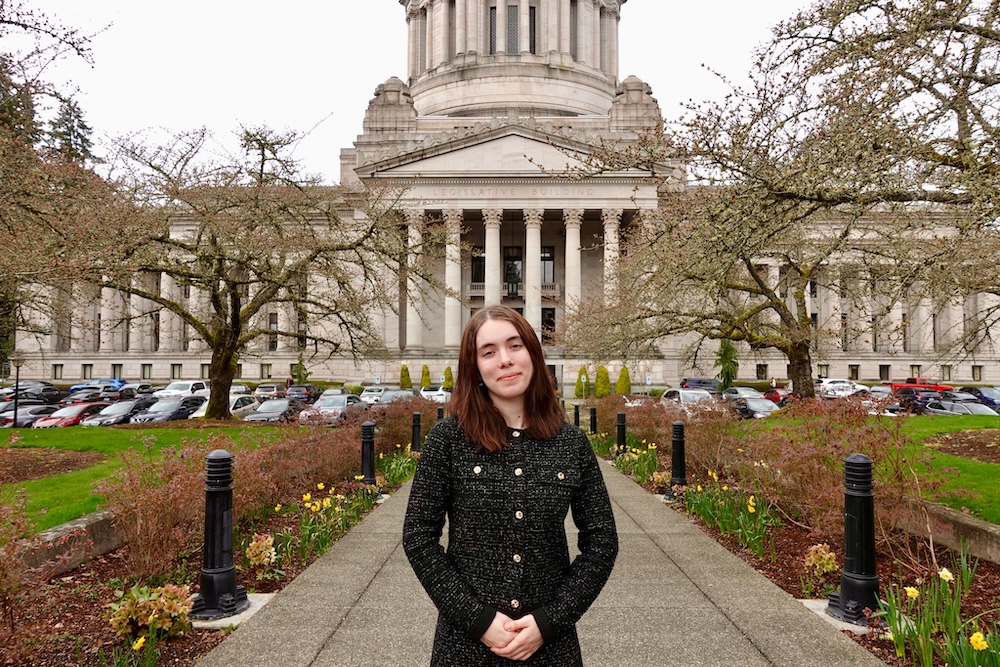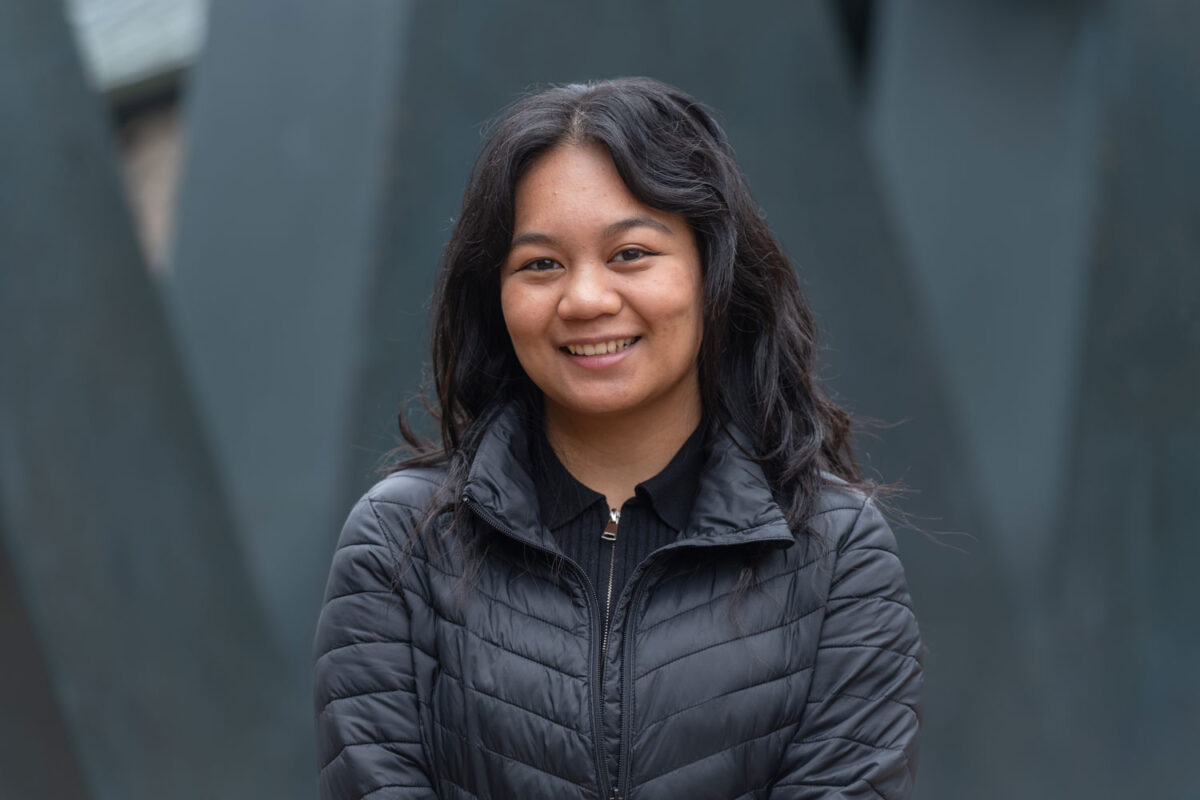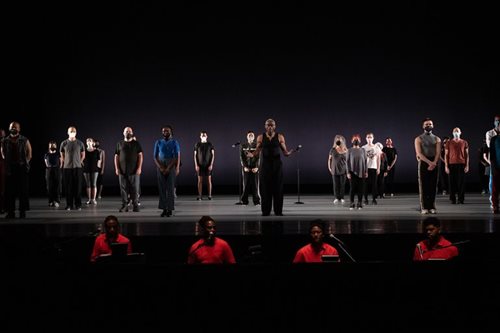
The spotlight was — quite literally — put on students and faculty in the University of Washington Bothell’s Master of Fine Arts in Creative Writing & Poetics program as they took to the stage in What Problem?, a touring production by the Bill T. Jones/Arnie Zane Company of New York.
The performance over the weekend of March 24 featured spoken word poetry, live choral music, a deconstructed text from Dr. Martin Luther King Jr.’s “I Have a Dream” speech and reflections by Bill Jones on the character of Pip in Herman Melville’s Moby Dick.
It was described in the press as a performance that “provokes the tension between belonging to a community and feelings of isolation that many feel during these divisive political times.”
Amplifying voices and experiences
Students and faculty from UW Bothell were able to participate in the performance as Jones chose to include a cast of local community members from each of the tour locations. He wanted to make each performance specific to its host city as the work is about community and coming together in spite of differences.
According to participants, the culmination of these differences has caused a divide within society. From the 2020 election to disagreements about how to best manage the spread of COVID-19 to the murder of George Floyd, the performance explored how racism is embedded in each of these instances.
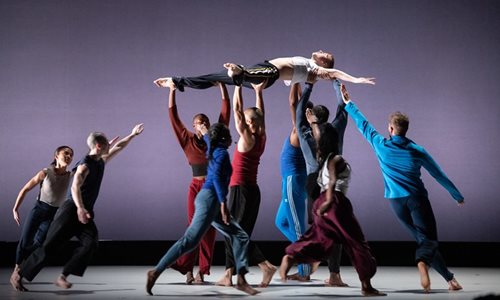
Wanting to create beauty from pain, individuals — strangers from a myriad of backgrounds —came together to participate in a groundbreaking show with only a matter of days to learn the steps and build trust with one another. They had a hand in the final act as they joined the touring cast on stage. They moved collaboratively through themes and motifs which were portrayed by their bodies as they were raised by the hands of others and, moving through various positions, portrayed vulnerability and strength.
Gavin Doyle, lecturer in the School of Interdisciplinary Arts & Sciences and one of the community performers, said that “The group movement, running, lifting and lowering of others, and the forming of precise shapes with my body was one of the most difficult and meaningful things I’ve done in decades.”
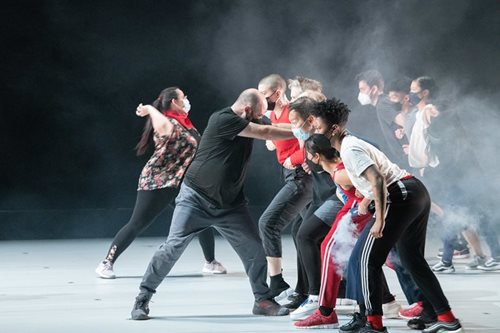
New, inspiring perspective
The movements expressed in the final performance called back to the previous acts and were followed by concluding statements from each performer.
Divided into two groups on stage facing each other, the dancers stepped up to a microphone one by one to say something they know about themselves and American society. “People told personal truths about family, addiction, culture, sexuality, women’s rights and more. It felt raw and honest,” Doyle said. “I finished my last performance with the statement, ‘I know that my family in Ukraine deserves to live. And deserves to live free.’”
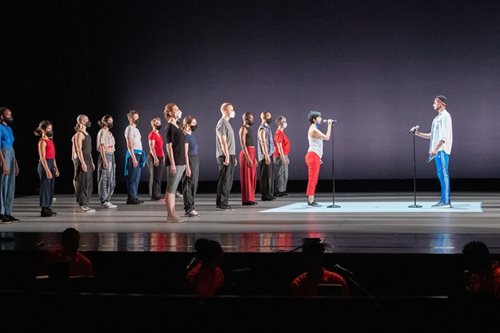
Alumna Emma Carson (MFA ’16) also participated in the performance and thought the “I know” segment was particularly powerful. “He challenged us all to consider what we know carefully and find something vital to say with our opportunity to speak,” she said. “I think we should all get behind that work.”
During the opening night’s post-production discussion, many of the community cast members agreed that their participation with Jones and his art effectively passed something on to them: a new inspiring perspective on community.
Exploring collective redemption
Carson joined the community cast through an open call in her alumni mailing list. As a poet and visual artist, she felt privileged to learn about dance alongside so many people whose perspectives and skills shone. “Our rehearsal guides were company dancers Huiwang Zhang, Marie Lloyd Paspe and Jacoby Pruitt who worked with us from day one to realize the movement and spirit of the performance,” Carson said. “It always felt like we were collaborating on something bigger than ourselves and yet which made room for everyone.”
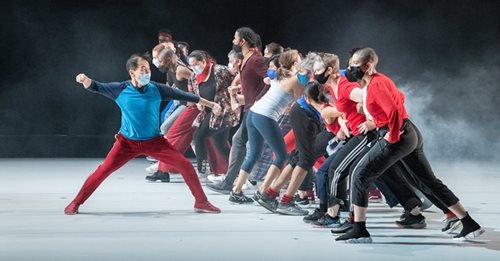
First-year MFA student Dria Simmons took part in the performance as well. Although Simmons had sparse experience in both dance and theater, it was the words “community participation” in the subject line of a simple email that immediately captured her interest in the What Problem? production opportunity. Since the beginning of the COVID-19 pandemic, that particular phrase might have been used to describe collective efforts to wear masks and keep social distancing alive, except this promised to be something inherently different, something more.
On the tailwinds of an isolating era consisting of unexpected quarantines and unpredictable lockdowns, the production emphasized the loneliness one can experience both alone and within a community. It explored the need for community and the notion of collective redemption.
“There are so many wonderful aspects of the experience I could rave about,” Simmons said. “I learned so much — about myself and about community — in such a short amount of time. It was a privilege to be a part of something that not only lends a voice to the Black experiences of America but also speaks of the importance of your fellow man, the necessity of human connection, outreach and healing.”
The idea of belonging
First-year student Raelynne Woo also participated in the performance. She came into UW Bothell’s MFA program with many years of dance experience, mostly in ballet. When rehearsing the part of a community member in What Problem?, she recalled, “It’s dance but not the way we are used to, like watching a dance recital. It’s abstract, interpretive — and pushes the boundaries of dance and what it can be.
“In ballet, the atmosphere is filled with pretty costumes, smiling until your cheeks hurt, proper technique and in my case dancing with other girls who were around my age,” she said. “In this environment, there is a different kind of intensity about being in a diverse group of people, wearing everyday clothes, where the act of simply walking or running is supposed to communicate something about the divisive times we live in and the idea of belonging.”
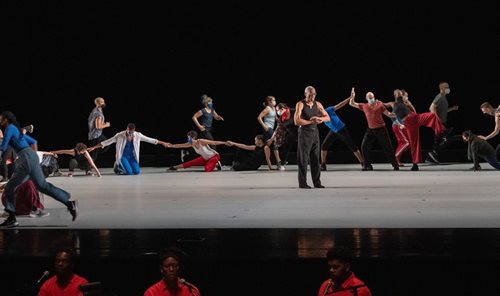
Coming from a formal dance background, Woo will admit that this kind of dance was out of her comfort zone and is not at all what she was used to growing up, but she was excited to see how movement and dance could be used to enhance the meaning of writing and poetry. “I didn’t think that I would get back into dance, so I am very grateful for this opportunity to work with such talented performers to broaden my knowledge of dance in a new way,” she said.
While Woo and Simmons knew one another prior to the performance, the duo had not yet met alumna Carson. The experience of dancing together achieved, in part, one of the goals of both the MFA program and the performance itself: building community in divisive times.
Inspiring perspective on community
Not only did the production deliver in terms of remarkable performances by Jones and his traveling company, but like a watering hole is to the parched, the experience revitalized the performing local community cast — which also included Diana Garcia-Snyder, lecturer in the School of IAS.
“It was life-changing to be on stage with the New York-based Bill T Jones/Arnie Zane Dance Company. I learned so much in such a short time from Bill’s presence and from his cast,” Garcia- Synder said. “I felt inspired and empowered by the clarity of their creative process, and Bill’s commitment to create honest and fearless work. They all were so generous and open with the members of the UW and dance community. I felt seen and heard and in a boat where everybody was rowing harmoniously despite the waves of COVID-19.
“It was great to participate in a production that celebrated justice and community at a time that we needed it the most.”
Byline: UW Bothell MFA students Raelynne Woo and Dria Simmons and alumna Emma Carson ’16
Photos courtesy of Jim Coleman

